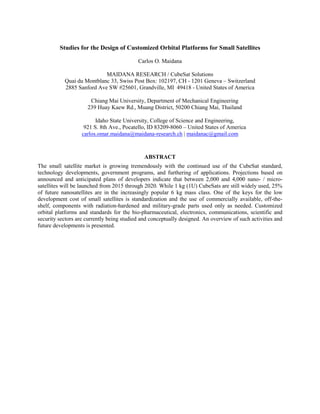CubeSat Solutions Abstract 2015
- 1. Studies for the Design of Customized Orbital Platforms for Small Satellites Carlos O. Maidana MAIDANA RESEARCH / CubeSat Solutions Quai du Montblanc 33, Swiss Post Box: 102197, CH - 1201 Geneva ŌĆō Switzerland 2885 Sanford Ave SW #25601, Grandville, MI 49418 - United States of America Chiang Mai University, Department of Mechanical Engineering 239 Huay Kaew Rd., Muang District, 50200 Chiang Mai, Thailand Idaho State University, College of Science and Engineering, 921 S. 8th Ave., Pocatello, ID 83209-8060 ŌĆō United States of America carlos.omar.maidana@maidana-research.ch | maidanac@gmail.com ABSTRACT The small satellite market is growing tremendously with the continued use of the CubeSat standard, technology developments, government programs, and furthering of applications. Projections based on announced and anticipated plans of developers indicate that between 2,000 and 4,000 nano- / micro- satellites will be launched from 2015 through 2020. While 1 kg (1U) CubeSats are still widely used, 25% of future nanosatellites are in the increasingly popular 6 kg mass class. One of the keys for the low development cost of small satellites is standardization and the use of commercially available, off-the- shelf, components with radiation-hardened and military-grade parts used only as needed. Customized orbital platforms and standards for the bio-pharmaceutical, electronics, communications, scientific and security sectors are currently being studied and conceptually designed. An overview of such activities and future developments is presented.

